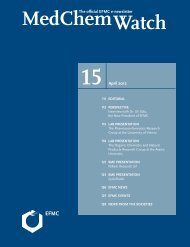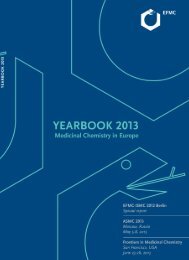You also want an ePaper? Increase the reach of your titles
YUMPU automatically turns print PDFs into web optimized ePapers that Google loves.
<strong>EFMC</strong> EVENTS<br />
in <strong>chem</strong>istry and biology. Morning talks<br />
also included novel synthetic approaches<br />
for enantioselective functionalization<br />
of C-H bonds to develop green and<br />
efficient synthesis of heterocycles and<br />
other biologically relevant motifs. Harmonized<br />
with these talks also the <strong>med</strong>icinal<br />
<strong>chem</strong>istry approaches had its place<br />
with case histories of the discovery of<br />
tofacitinib (CP-690,550), a potent and<br />
selective JAK inhinbitor and TMC435,<br />
a novel macrocyclic hepatitis C virus<br />
protease inhibitor. The story behind the<br />
discovery of GPR119 for the treatment of<br />
type 2 diabetes was also one of the interesting<br />
presentations of the first day in<br />
the symposium. The second day mostly<br />
emphasized on the changing face of<br />
complex, time consuming and expensive<br />
drug discovery process indicating<br />
the place of novel approaches such as<br />
<strong>chem</strong>ical biology and epigenetics, with<br />
a focus on identifying novel molecular<br />
targets and new molecules to support<br />
the construction of an enhanced and<br />
robust drug discovery pipeline. In addition,<br />
presentations regarding synthetic<br />
organic <strong>chem</strong>istry, i.e., chiral synthesis,<br />
synthesis of novel conformationally rigid<br />
diamines, a new catalytic system<br />
for C-H activation, synthesis of bicyclic<br />
peptide systems, novel synthetic approaches<br />
in the preparation of pharmaceutically<br />
important heterocycles and<br />
MCW104<br />
their relevant biological potentials, were<br />
successfully organized as a part of each<br />
session. Third day of the symposium<br />
was started with focusing on the role of<br />
bioactive natural products in the drug<br />
discovery. Chemical biology of the natural<br />
product cyclopamine as an inhibitor<br />
of hedgehog signaling and novel synthetic<br />
methodologies for total synthesis<br />
of polyphenol-based natural products<br />
were the interesting and scientifically<br />
rich presentations along with development<br />
of novel azetidine urea derivatives<br />
as fatty acid amide hydrolase inhibitor<br />
VER-158416. Another new finding on the<br />
importance of halogen bonding in protein-ligand<br />
interaction and binding affinity<br />
was also succesfully discussed during<br />
presentations. Last day of the symposium<br />
also concentrated on the synthetic<br />
new methodologies on asymmetric synthesis<br />
of bioactive molecules such as<br />
MFPA and chaetocin and their relevant<br />
biological properties. Again C-H activa-<br />
The Gala Dinner<br />
tion reactions and metal-catalyzed C-H<br />
bond functionalizations for use in <strong>med</strong>icinal<br />
<strong>chem</strong>istry were the continuation<br />
of first talks in this topic and overall the<br />
importance of C-H bond activations in<br />
the synthesis of novel <strong>chem</strong>otypes and<br />
for providing a utility to develop novel<br />
drug-like molecules were clearly dealth<br />
with during the symposium. Along with<br />
the synthetic <strong>chem</strong>istry presentations,<br />
the stories on the validation of N-myristoyltransferase<br />
as a new therapeutic<br />
target, development of mGluR4 positive<br />
allosteric modulators for Parkinson’s disease,<br />
oncologic drug development efforts<br />
targeting Wnt/β-catenin pathway,<br />
use of natural product grandisine alkaloids<br />
as δ-opioid receptor antagonists<br />
and discovery of novel antimalarial <strong>chem</strong>otypes<br />
were very exciting in a way that<br />
although the use of modern approaches<br />
have widely been utilized to identify and<br />
understand the structural interactions<br />
of lead compounds for clinical development,<br />
the use of conventional and novel<br />
<strong>chem</strong>ical strategies were the main driven<br />
force for the success of each story.<br />
Once more, the ASMC meeting series<br />
successfully enlightened the close<br />
connection between synthetic organic<br />
and <strong>med</strong>icinal <strong>chem</strong>istry and carried a<br />
message that changing face of organic<br />
synthesis for making biologically important<br />
molecules has a pivotal role using<br />
<strong>med</strong>icinal <strong>chem</strong>istry approaches more<br />
efficiently in drug discovery process.





